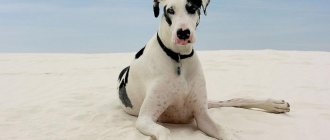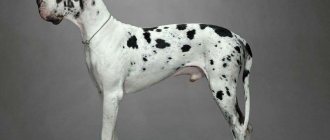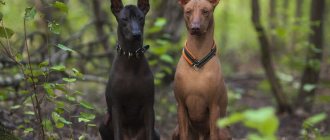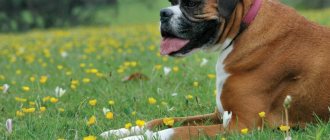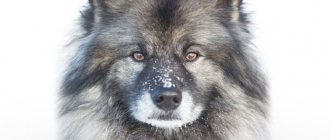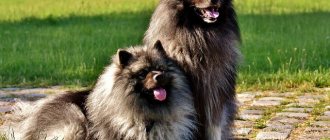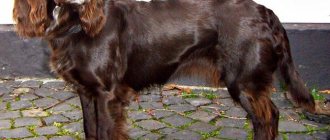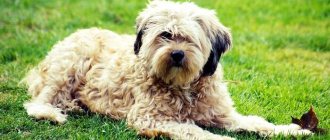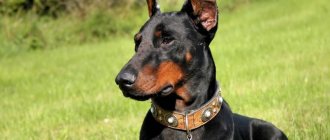Great Danes are one of the most popular breeds in the world. This is a fairly large, even gigantic dog with excellent guarding qualities. At first glance, she seems formidable and dangerous, but in fact she is not at all aggressive. Great Danes are smart, affectionate and loyal pets, loving children and unobtrusive. But due to their huge size, there may be problems in their maintenance. Therefore, before getting a Great Dane, you need to study the description of the breed and care features. Owner reviews will help you better understand the pros and cons of these pets.
- Description of the head
- Education and training
- Care
Breed traits
Breed traits (on a 5-point scale)
| German dog | |||
| Activity | in the house | 2 | |
| on the street | 3.1 | ||
| Obedience | training | 3.6 | |
| strangers | 4.5 | ||
| Domination | in family | 1.8 | |
| over dogs | 2.5 | ||
| Defending your territory | from people | 2.9 | |
| from dogs | 3.4 | ||
| Sociability | in family | 4.9 | |
| with strangers | 3.7 | ||
| with dogs | 3.3 | ||
| Concentration | in family | 1.1 | |
| in front of strangers | 1.9 | ||
| with dogs | 2 | ||
| Aggressiveness | in family | 1.1 | |
| to strangers | 1.8 | ||
| to the dogs | 2 | ||
| to cats | 2.2 | ||
| Family behavior | calmness | 4.4 | |
| demand for affection | 4.7 | ||
| excitability | 3.3 | ||
| playfulness | 3.6 | ||
| excessive barking | 1.7 | ||
| behavioral breakdowns | 1.8 | ||
| Tolerance for children | up to 4 years | 4 | |
| over 4 years old | 4.2 | ||
| Institutional use | watchman | 4.3 | |
| bodyguard | 2.6 | ||
This breed is often compared to the following dog breeds: Doberman (Doberman Pinscher), German Shepherd, Dalmatian, Cane Corso, Longhaired Collie.
The photographs show what Great Danes look like:
Marbled Great Dane
Two Great Danes
Great Dane head
Two marbled Great Danes
Key points in training
Most representatives of the breed are distinguished by their kindness and flexible character. There are practically no problems during training; dogs learn both simple basic commands and complex ones well.
It is advisable to start training a Great Dane at six months of age; at this age he is most quickly amenable to training. Starting from the age of one, a dog can begin to show character, and after two years it is extremely difficult to change an already formed character.
It should be noted that the owner must build his authority gradually, with the help of affection and encouragement. If you use brute physical force in training, the dog will definitely try to overthrow the tough “leader”. Corporal punishment can also damage the psyche of a well-balanced dog.
The dog is always alert and ready to protect its family
General characteristics of Great Danes as a breed
Great Danes are one of the largest dogs. Their height can reach 110 cm, and some representatives of the breed weigh more than 90 kg. But despite their enormous size, Great Danes are not evil. These are calm, intelligent and very loyal animals. They do not show aggression and are quite sociable. Although this is an excellent guard and watchman, when danger arises, it boldly rushes to protect the owner and his property.
The Great Dane is also popular because of its elegant, beautiful appearance. This is an aristocrat and even the Apollo of the dog world. For this reason, the breed is often called the Royal Dane.
The main characteristics of the Great Dane are independence, good nature, calmness, and intelligence. The breed can be used as a bodyguard, guard, watchman, in guard and escort service. But it is also a wonderful companion, devoted friend, nanny and protector for the child. These dogs are ideal for large families, respectful of people and easy to train.
The photo shows that Great Danes are huge but good-natured dogs:
Walking with a little girl
Huge Great Dane
Great Dane with a child
| Options | Characteristic |
| breed name | Great Dane, Royal Dane |
| country of origin | Germany |
| time of adoption of the first standard | 1880 |
| group of breeds according to the ICF classification | Molossians, mastiff subsection |
| height | males 80-90 cm, females 72-84 cm |
| weight | males 63-79 kg, females 50-63 kg |
| life expectancy | 8-10 years |
| usage | watchman, security guard, companion |
| character traits | calm, loyal, fearless, good-natured, intelligent, reliable, cheerful |
| aggressiveness | do not show aggression, get along well with other pets |
| activity | tall, needs long walks with running and outdoor games |
| intelligence | smart |
| training | uncomplicated |
| attitude towards people | friendly, loyal, love children, suspicious of strangers |
| need for communication | sociable, do not tolerate loneliness well |
| health | weak, live on average 5-7 years |
| care | easy, moderate shedding |
Pros of the breed
Great Danes are popular dogs for families with children and active young people. The breed is suitable even for inexperienced owners, as it is non-aggressive and easy to train. These pets have many advantages:
- balanced psyche;
- obedient, calm character;
- unobtrusive, intelligent behavior;
- impressive, beautiful appearance;
- rarely bark;
- devotion, sociability, good nature;
- high intelligence;
- no aggression towards strangers and other animals;
- are a good companion, ready to accompany the owner everywhere;
- can become a nanny and a reliable protector for a child;
- short hair, sheds lightly.
Cons of content
But these pets have serious disadvantages. Due to their height, Great Danes are difficult to keep in a city apartment. They are not suitable for very busy people, as they require a lot of attention and do not tolerate loneliness well. There are several other disadvantages of the content:
- requires a lot of space in the apartment for sleeping and playing;
- cannot be kept in an enclosure;
- Because of their short fur they get cold in winter;
- large weight and size can become a problem during active games, the dog can accidentally cause injury;
- high consumption of products;
- poor health, Great Danes rarely live longer than 8 years;
- high physical activity required;
- increased salivation.
The video complements the information about the pros and cons of Great Danes:
Video: Great Dane
Video: Great Dane pros and cons of the breed
Interesting facts about the Great Dane breed
This is a young breed that appeared in the 19th century, although such large dogs have served people since ancient times. A lot of interesting facts about Great Danes have accumulated.
- Great Danes are giant dogs. For their height they are included in the Guinness Book of Records. A Great Dane named Zeus had a height at the withers of 110 cm, and when he stood on his hind legs, the height of this giant reached 220 cm. And the dog George, with a height of 109 cm, weighed more than 100 kg.
- Sometimes you can find the name “Royal Great Dane”. The dogs are called this because of their enormous size, but they are the same breed.
- Many people know the breed thanks to the cartoon about Scooby-Doo - a funny and cowardly Great Dane. Although in fact real dogs do not look like this character.
- In ancient times, similar dogs were found in all countries. They took part in dog fights, helped people in war, and guarded property. In England they were used for hunting. But the breed is called German, since the first standard was developed in Germany.
- In Russia, the Great Dane appeared even before the revolution, but was not popular. During World War II, all dogs of this breed were destroyed.
- These dogs have the shortest life expectancy. Even in favorable conditions, they live on average 6.5-7 years.
Pictures from the Internet show what an interesting dog the Great Dane is:
Great Dane and Chihuahua
Three merle Great Danes
Got bored
Can drink water on his own
Great Dane and cat
Application
Previously, Great Danes were used, like Hovawarts and Groenendaels , as hunters and bodyguards, as fighting dogs and even sled dogs.
Today, due to their wonderful character, these dogs become good watchdogs and companions.
They can be safely acquired by those who have no experience in dog training .
You can read about other dog breeds for beginners here:
The Great Dane dog is incredibly cheerful, she is ready to stick her tongue out at any problem.
History of the origin of the Great Dane dog breed
The Great Dane was originally bred to protect property. The first breed standard was developed in Germany at the end of the 19th century. Although mastiff dogs have lived next to humans since ancient times. This group includes mastiffs, Rottweilers, bulldogs, Dalmatians, St. Bernards and many others. Previously, they did not have a name; the word “dog” was used to describe all large dogs.
Their ancestor is the Tibetan Great Dane, one of the most ancient breeds. From archaeological finds and found images, one can understand that such dogs served man more than 3 thousand years ago. They were used for guarding, hunting, protecting herds and property. In Asian countries, Great Danes took part in wars and were valued. Killing this dog was a crime.
Gradually, the mastiffs spread throughout the world, reaching Europe with traders and legionnaires. Such dogs were bred in different countries. But they differed in build, color and did not belong to the same breed. There were Great Danes of Ulm, Hunting, English, Danish.
Such dogs were especially valued in Germany. By the end of the 19th century, a new breed began to be developed here based on the best representatives of the mastiffs. The first standard was created in 1880. And in 1888, the Great Dane breed was officially recognized and began to spread throughout the world. The International Canine Association classifies it as a Molosser.
Possible diseases
There are no specific diseases unique to this breed. But Great Danes get sick no less than other dogs; most often they suffer from the following ailments:
- joint problems – dysplasia, osteochondrosis;
- heart disease - cardiomyopathy;
- ear diseases – otitis media, ear mites;
- infectious enteritis - affects the liver and digestive system;
- ulnar bursitis - a neoplasm in the form of a tumor, appears due to sleeping on a hard surface;
- volvulus of the stomach.
You should not self-medicate your dog. Some diseases, such as gastric volvulus, are fatal if you do not seek help from a veterinarian in a timely manner.
Great Danes: appearance and standard
Great Danes are large, beautiful animals. Due to their wide popularity and frequent use in cinema and animation, many people know what they look like. They have a powerful, harmoniously built body, long legs, and a large narrow head. Features of appearance can also include noble posture, pronounced muscles
Photos of Great Dane dogs:
In terms of size, Great Danes are classified as large or even giant breeds. They are tall - the average height at the withers is 80 cm. The body format is almost square. Only in females the body length is 10% greater than the height. The weight of Great Danes often reaches 90 kg. Although on average they weigh about 60 kg. But despite this, they are elegant, agile and hardy.
Description of the head
The Great Dane has a large, elongated, harmoniously built head. When viewed from the front, the muzzle appears narrow. But its shape is rectangular, slightly flattened on the sides. The brow ridges are pronounced, the stop is located in the middle and is clearly visible. The forehead and bridge of the nose are wide. The eyes are medium in size, round, set wide apart. They are dark, usually brown. Blue dogs can be lighter in color, while merle dogs can have different colors - heterochromia.
The jaws are strong, the teeth are large, and the bite is scissor-shaped. The nose is large and wide. The lobe is black, slight lightening is acceptable with marble colors. The lips are dark, the corners are well defined. The upper lip hangs down.
The Great Dane's ears are set high. They are large, triangular in shape, hanging. Where docking is allowed, the ears are triangular and erect. You can crop ears with dense cartilage; this is now done for cosmetic purposes. But after 1993, the ear cropping procedure was banned in many countries.
Body and tail
The physique is harmonious, almost square in shape. The neck is long, muscular, set high and vertical. Expands from the back of the head to the withers, the scruff is well defined. The chest is deep, the stomach is tucked. The back is straight, the loin is short. The croup is wide and slightly sloping.
The tail is set high, long, saber-shaped. Usually hangs down freely. Even in an excited dog it does not rise above the line of the back.
Limbs
The limbs are long, straight, set parallel. They are muscular and strong. The forelimbs are level, the forearms are long, the elbows are directed straight back. The hind legs are strong, the joints are well defined, the shins are long. The paws are arched and closed like a cat. The dog's movements are springy and smooth.
The pictures complement the description of the appearance of the Great Danes:
Features of wool
The coat is very short, shiny and smooth. It is dense, fits well to the body, there is no undercoat. She does not shed much, in spring and autumn. The skin is wrinkle-free and elastic. There are no sweat glands on it, so the dog has no odor.
Great Dane colors
There are only 5 colors of these dogs that are recognized as the standard.
- Brindle – on a red background there are black or gray stripes in different places. They are clear, located parallel to the ribs. The muzzle is dark to the eyes. No other colors should be present.
- A pure black Great Dane is rare. It has a uniform color, only small white spots are allowed on the chest and tips of the paws. The more common color is “cloak” or platten. In such individuals, the upper part of the body is black, and the chest, neck, belly, and paws are white.
- Fawn Great Danes are red or golden and black. But the dark color, unlike brindle, is present evenly on the face and ears. Fawn-colored dogs do not have patches of gray or brown, and white spots are also not desirable.
- Blue Great Danes are uniformly dark gray or silver in color. When viewed from a certain angle, it takes on a blue tint. White spots on the chest and toes are acceptable. There should be no black or brown tints.
- Marbled Great Danes are the most popular and look beautiful. They have black spots unevenly spaced on a white background. Gray or brown color is undesirable. Such dogs are also called white Great Danes or harlequins.
Photos of Great Danes of different colors:
Varieties
Now there are three varieties of Great Danes based on color:
- brindle and fawn - with black markings on a red background;
- black or marble (a combination of white and black);
- blue.
The standard does not allow crossing representatives of the breed of different colors. Individuals with incorrect colors will be disqualified. It is typical that puppies are born with a light coat color. The color begins to appear after some time. Albinos are also found in this breed - completely white, without pigmentation. Since they do not meet the standard, they are not allowed for breeding.
What is merle color in dogs?
Marble coloring is a weakening of the main color in certain areas of the coat. From the outside it looks like a lot of chaotic light spots on top of a darker tone. A symmetrical arrangement is rare.
In addition to the fur, the unusual colors affect the eyes. Because of this, heterochromia develops - uneven color of the iris. The eyes become multi-colored or speckled.
Marble on wool is very rare. In many breeds it is equated to marriage, citing a possible danger to the health of the animal.
Character of Great Danes
The Great Dane is an affectionate, good-natured and calm pet. Puppies can be mischievous and can knock down even an adult during play. But this goes away with age. Moreover, they never play pranks, do nothing out of spite, and do not know how to take revenge.
An adult Great Dane is a faithful friend and companion, a reliable protector and nanny for a child. He needs to constantly be close to the owner and his family members, to take care of them and protect them from dangers. Great Danes are very gentle with children, they will never offend, and they allow any liberties. But this dog does not tolerate loneliness well, and may even become depressed or sick.
These are surprisingly intelligent and peaceful animals, affectionate with members of their family and not angry towards strangers. They get along with other pets, do not get into fights with dogs, and do not chase cats or birds. But calmness and indifference to others is only external. This dog keeps a watchful eye on everyone. At the slightest danger, it fearlessly rushes to protect its owner.
The Great Dane has the following character traits:
- calm;
- reliability;
- devotion;
- sociability;
- cheerfulness;
- fearlessness;
- friendliness;
- self-confidence;
- obedience;
- patience.
Great Danes can sometimes be stubborn and lazy. They do not strive for dominance, but even a well-mannered adult dog may not obey the owner’s commands. These dogs are willful and capable of making independent decisions. Their negative character traits include jealousy and resentment. They react sharply to rudeness and can be offended for several days.
Education and training
The Great Dane is very easy to train. This is due not only to high intelligence, good memory and the desire to please the owner. These pets subtly sense a person’s mood, are able to detect the slightest changes, understand gestures and facial expressions. But for training to be effective, the dog must be interested.
The puppy begins to be raised from the first days of its arrival in the house. Training should be carried out in a playful way, avoiding monotony. Great Danes are smart and quickly understand what is required of them. You need to start with the basic commands: “come to me”, “place”, “sit”, “no”. On the street you need to learn to walk nearby and stop on command. From 5-6 months you can teach how to fetch an object, the commands “give paw”, “bring”, “barrier”.
Great Danes require early socialization and training. You need to get used to loud noises, strangers, cars. If raised incorrectly, a dog can grow up aggressive and uncontrollable. And with such a size, this can cause serious problems. Therefore, you need to pay a lot of attention to training. A Great Dane must obey its owner unquestioningly.
During training you need to remain calm and be patient. It is not advisable to raise your voice at a dog; you cannot hit him. When a dog does something forbidden, it is enough to tell him “no” or “ugh”. These animals understand disapproval in a person's voice. And the worst punishment for them would be to be ignored. For correct behavior, be sure to praise, encourage with affection or treats.
Interesting video about the peculiarities of raising Great Danes:
Video: A calm walk with a giant
Video: DT-81. Anxious Great Dane.
Merle color varieties
Depending on the main color, the following types of marble are distinguished:
- blue merle (blue) - lightening black to gray;
- red merle (red) - lightening red to cream or light brown;
- sable merle (sable) - a combination of sable color and blue merle (immediately after birth, the puppy appears almost white, but darkens as it grows up);
- cryptic merle (hidden) - resembles a tricolor; the presence of the M gene can only be indicated by a tiny silver speck (most often determined only by genetic analysis);
- white merle (double or double) - most of the body is painted white, spots are practically or completely absent.
The last type is the most dangerous. This is what is obtained when mating 2 spotted dogs. It is distinguished from the plain white color by the absence of pigmentation on the skin. Double merle puppies are born with pinkish lips, nose and eyelid rims. While in truly snow-white dogs (for example, Samoyeds), these areas are always painted black.
Features of keeping Great Danes
In an apartment, especially a small one, this giant will feel cramped. Better for him is a private house with a large plot. But you can’t keep Great Danes in an enclosure for a long time. They require constant communication with humans, especially since in cold weather they freeze quickly. In the room you need to provide your pet with a large lounger or sofa. It is advisable to do cleaning daily, as these dogs are prone to drooling.
The Great Dane needs long walks (at least 2-3 hours a day) and physical activity. He needs to run a lot, preferably to the park or forest. Great Danes love to swim and play sports. In the city it is better to walk your pet on a leash. With enough walks at home, the dog will behave calmly.
Care
Caring for Great Danes is easy. The coat is short, without undercoat, so it does not shed much. It is enough to comb it once a week with a massage mitten or a soft brush. During shedding, this should be done daily.
Your pet should be taught hygiene procedures from an early age. Bathing is often not recommended, as it disrupts the natural protective skin barrier. 2-3 times a year is enough. After walks, you need to wash your paws and, if necessary, wipe the fur with a damp towel. Great Danes do not have sweat glands, so they do not smell like dogs. For washing you need to use veterinary shampoo.
It is often necessary to wash your pet's face. Great Danes are prone to drooling due to their overhanging upper lip. It is advisable to clean the mouth of food debris and saliva several times a day. The usual hygiene procedures for all dogs will also be required.
- Inspect and clean the ears regularly, especially if they are not cropped. Dirt and sulfur can accumulate in them, which will lead to inflammation.
- It is advisable to wash your eyes every day to prevent them from becoming sour.
- Teeth should be brushed with veterinary paste or given special chewing bones. This will help prevent the formation of tartar and unpleasant odor from the mouth.
- Great Danes have short claws; if you constantly walk on asphalt, they wear down naturally. If not, you need to trim them, maybe every week.
- These animals have sensitive skin and often have calluses and irritation on their paw pads. Lying on a hard floor may cause abrasions on the elbows. You need to lubricate these places with a special cream or vegetable oil.
Health
The Great Dane is not in good health. These pets rarely live beyond 9-10 years, usually dying at the age of seven or eight. In order for your pet to spend this time without illness, proper care and regular examinations by a veterinarian are needed.
The most common problem is volvulus. Due to their large size, these dogs are also prone to pathologies of the musculoskeletal system: joint dysplasia, arthritis, osteochondrosis, and injuries are possible. They also have the following diseases:
- obesity;
- cardiomyopathy;
- renal failure;
- hypothyroidism;
- dermatitis;
- allergic reactions;
- deafness;
- cataract, glaucoma.
Nutrition
The Great Dane is a large animal, so it requires a large amount of food. The easiest way to meet your pet's nutritional needs is with high-quality dry food. It is better to choose super-premium options. They are made from natural meat and contain vitamins, minerals, antioxidants, fiber, and fatty acids.
It is advisable that the food is intended specifically for large breeds and contains chondroprotectors to protect joints. Acana, Orijen, Now Fresh, Grandorf, Farmina N&D, Brit Care, Eukanuba are suitable.
If you choose natural food, an adult dog will need 600-800 g of meat per day. It is better to give chicken, rabbit or beef. You also need cereals, vegetables, and dairy products. It is forbidden to give pork, fatty and spicy foods, sweets, smoked foods, and baked goods. Additionally, your pet needs vitamin supplements.
You cannot feed your dog from your table; Great Danes have a weak stomach and a slow metabolism. They are prone to volvulus, weight gain, and should not be overfed. For the same reason, physical activity after feeding is contraindicated for pets. You need to feed your Great Dane after a walk.
More interesting photos of Great Danes:
What to feed
Such a large size of the dog suggests that it consumes a large amount of food. So the owner, when buying a puppy, must understand what he is getting into, because now the budget must be allocated for another family member.
To maintain healthy ligaments and muscles in proper condition, you should take care of complete food, which, in addition to the correct ratio of proteins, fats and carbohydrates, should be rich in vitamins and microelements necessary for the dog. Without this complex, the Great Dane will look sickly and its life expectancy will be sharply reduced.
It is very difficult to combine the entire set of substances necessary for a dog on natural food. It is much easier to feed ready-made dry food. The packaging must indicate that the food contains an important chondroprotector for these dogs - a substance that promotes the proper formation and functioning of joints. Such as Eminent Adult Large Breed or Happy dog.
The diet of puppies, adolescents and adult dogs varies, so you should buy food that is appropriate for their age.
Important! Dry dog food must be of very high quality, at least premium.
The second feeding option is natural. The puppy should be fed at regular intervals. From two to eight months, you should limit fats in the diet, replacing them with proteins, this is necessary so that the dog does not gain weight very quickly, because this increases the load on the joints and they may not form correctly.
Puppies should be given:
- fermented milk products (cottage cheese, whey, low-fat kefir);
- porridge (rice, oatmeal, corn, buckwheat;
- beef cartilage and meat trimmings;
- omelette from egg yolks (quail, chicken);
- sea fish without skin and bones (if there is no allergy);
- boiled and fresh vegetables (carrots, beets, bell peppers, zucchini, cucumbers, tomatoes).
As soon as the puppy acquires the official status of an adult dog, his diet will consist mainly of vegetables, meat and grains. Calcium-containing foods, fish and eggs can be given only once a week.
How to buy a Great Dane puppy
Puppies of this breed are purchased at the age of 3-5 months. It is better to purchase a dog from bona fide breeders or a kennel. Before buying a puppy, you need to study reviews about the owners, visit the nursery and watch the animals. It is important in what conditions they are kept and how the mother behaves. The breeder must provide all the necessary documents, a veterinary passport with vaccination marks.
Puppies should be clean, cheerful, with smooth shiny coat. It is recommended to take the most active baby who does not show aggression or cowardice. He should have clean eyes, ears without discharge or unpleasant odor, and a soft belly.
The price of a purebred Great Dane in Moscow is 40-60 thousand rubles. Show class dogs will cost from 65 to 100 thousand. But in one litter there may be puppies with breeding defects, which will not be allowed to show. This usually does not affect the health and character of the pet. Such dogs cost 10-20 thousand rubles. It is impossible to buy a purebred Great Dane at a lower price; it will be a mixed breed.
The photographs show what Great Dane puppies should look like:
Great Dane puppies
Blue and merle Great Dane puppies
Before you decide to get such a large and intelligent dog, you should watch the video:
Video: Great Dane
Video: Great Dane - tender devotion and noble strength
Great Danes are ideal family dogs. They are not angry, sociable, calm. They love children very much and strive to constantly be in the center of attention. This dog should become a member of the family, then he will be a devoted friend and faithful protector. But for this it is necessary to provide him with normal living conditions and sufficient physical activity. Great Danes are strong and powerful dogs, but they need attention and care.
Price
The price of a Great Dane is determined by its color. Even purebred fawn and black animals are valued less than the rarer merle or plateau ones. Average prices for dark-colored puppies range from 15,000 to 30,000 rubles. You can buy a marbled or plateau puppy for 30,000 – 50,000 rubles and more.
The cost also depends on the seller. Prices are set higher than average by Great Dane kennels, and prices are set lower by private breeders. In addition, purchasing through a nursery is more reliable if the priority is the purebred of the animal’s breed.
Purebred Great Danes are highly valued. They are noticeably more expensive than puppies of such common large breeds as German Shepherd, Caucasian Shepherd, Labrador, and Retriever. That’s why only sincere connoisseurs of the breed prefer to have such a large dog, especially in urban conditions.
Why is this color considered dangerous?
When the M gene is inherited from both parents, puppies often die while still inside the mother's womb. If they manage to avoid death at the embryonic stage, then the following disorders await them at birth:
- atrophy of the ears or eyes;
- heart diseases;
- low fertility or infertility;
- ophthalmological pathologies (cataracts, night blindness, flattening of the fundus);
- mental disorders, including a tendency to increased aggression.
When breeding spotted animals, it is important to exclude the presence of hidden merle. To do this you need to take a genetic test.
